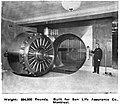Frederick S. Holmes | |
|---|---|
 | |
| Born | Frederick Stacy Holmes August 27th, 1865 in Boston, MA |
| Died | November 10th, 1948 (age 84) in Hathorne, MA |
| Education |
|
| Occupation | Vault Engineer |
| Era | Early 1900s |
| Known for |
|
| Political party | Republican / Independent |
| Spouse(s) | Katherine E. Vincent, married on March 27th, 1886 in Chelsea, MA |
| Children | None |
| Parents |
|
| Engineering career | |
| Discipline | Mechanical Engineering |
| Practice name | Frederick S. Holmes 2 Rector St. New York, NY |
| Significant design |
|
| Signature | |
| | |
Frederick S. Holmes was an American safe and vault engineer, [1] and inventor who designed the largest vaults in the world. During his career, Holmes designed over 200 vaults throughout the United States, Canada and Japan from 1895 [2] to 1941, considered to be the golden age of bank vault construction. The majority of Holmes designed vaults are located in New York's Financial District; many are publicly accessible and in buildings on the National Register of Historic Places. His name is engraved on the builder's plaques, typically located on the vault door's encased jamb controls.
Contents



Holmes' vault designs evolved over time to keep up with attacks from safe-crackers or 'Yeggmen' [3] adept at vault penetration. A Holmes advertisement from 1921 reads, "Newly discovered methods of attack necessitate radical departures from hitherto accepted standards of design". [4] Holmes specialized in jamb-controlled vaults where the combination locks and bolt-throwing mechanism are located inside the vault creating a solid vault door with no spindle holes. Entry requires two points of attack (door and jamb), which doubles the time required for burglars to breach the vault. [5] The culmination of vault door design resulted in the combination viewer which was used on the largest vaults ever built.
Holmes was an expert in his field and described as 'one of the leading, if not the leading vault engineer of America, and a man whose word is unquestioned by those who have had transactions with him'. [6] In recognition of significant contributions to the field of bank vault engineering, a tribute was written in The Journal of the Franklin Institute stating, [7] “Coincident with the modern development of the safe and bank vault industry was that of the profession of the Bank Vault Engineer. The industry owes much of its progress to the work done by the pioneers of this profession: William H. Hollar, [8] John M. Mossman, George L. Damon, [9] Emil A. Strauss, [10] Frederick S. Holmes, Benjamin F. Tripp, [11] and George L. Remington.” [12] Holmes worked with all these vault engineering greats except Strauss.
Holmes collaborated with prominent architects such as Darling & Pearson, Trowbridge & Livingston, Walker & Weeks, and York & Sawyer. He also worked with leading vault builders including Bethlehem Steel, Carnegie Steel, Damon Safe & Iron Works, [9] Diebold, Herring-Hall-Marvin, J&J Taylor, LH Miller Safe & Iron Works, [13] Mosler Safe, Remington & Sherman, [14] and York Safe & Lock. [15]



